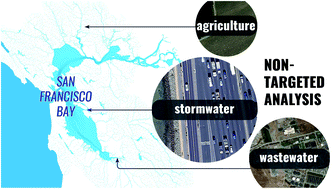Assessment of emerging polar organic pollutants linked to contaminant pathways within an urban estuary using non-targeted analysis†
Abstract
A comprehensive, non-targeted analysis of polar organic pollutants using high resolution/accurate mass (HR/AM) mass spectrometry approaches has been applied to water samples from San Francisco (SF) Bay, a major urban estuary on the western coast of the United States, to assess occurrence of emerging contaminants and inform future monitoring and management activities. Polar Organic Chemical Integrative Samplers (POCIS) were deployed selectively to evaluate the influence of three contaminant pathways: urban stormwater runoff (San Leandro Bay), wastewater effluent (Coyote Creek, Lower South Bay), and agricultural runoff (Napa River). Grab samples were collected before and after deployment of the passive samplers to provide a quantitative snapshot of contaminants for comparison. Composite samples of wastewater effluent (24 hours) were also collected from several wastewater dischargers. Samples were analyzed using liquid-chromatography coupled to high resolution mass spectrometry. Resulting data were analyzed using a customized workflow designed for high-fidelity detection, prioritization, identification, and semi-quantitation of detected molecular features. Approximately 6350 compounds were detected in the combined data set, with 424 of those compounds tentatively identified through high quality spectral library match scores. Compounds identified included ethoxylated surfactants, pesticide and pharmaceutical transformation products, polymer additives, and rubber vulcanization agents. Compounds identified in samples were reflective of the apparent sources and pathways of organic pollutant inputs, with stormwater-influenced samples dominated by additive chemicals likely derived from plastics and vehicle tires, as well as ethoxylated surfactants.

- This article is part of the themed collection: Environmental Science: Processes & Impacts Recent HOT Articles


 Please wait while we load your content...
Please wait while we load your content...